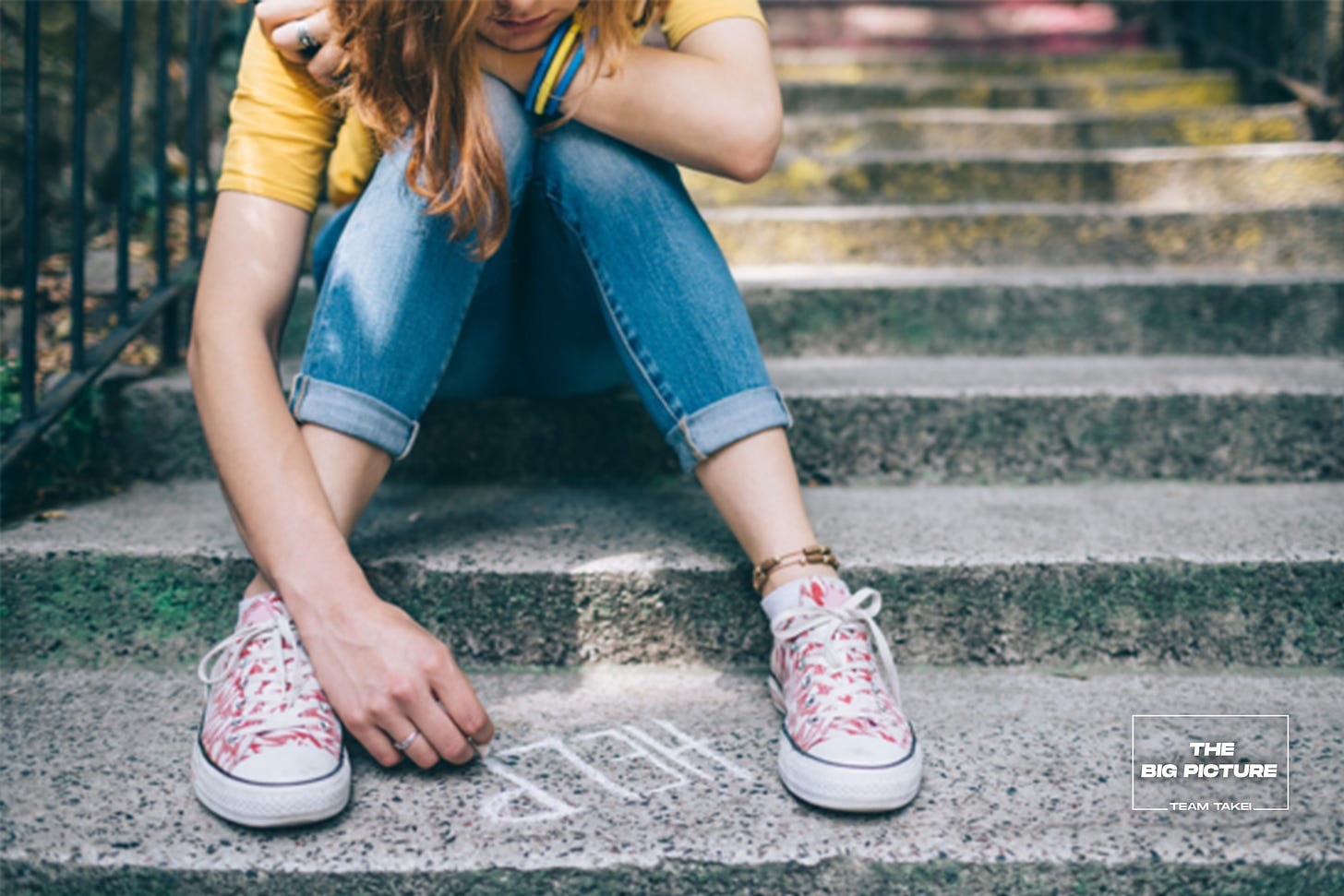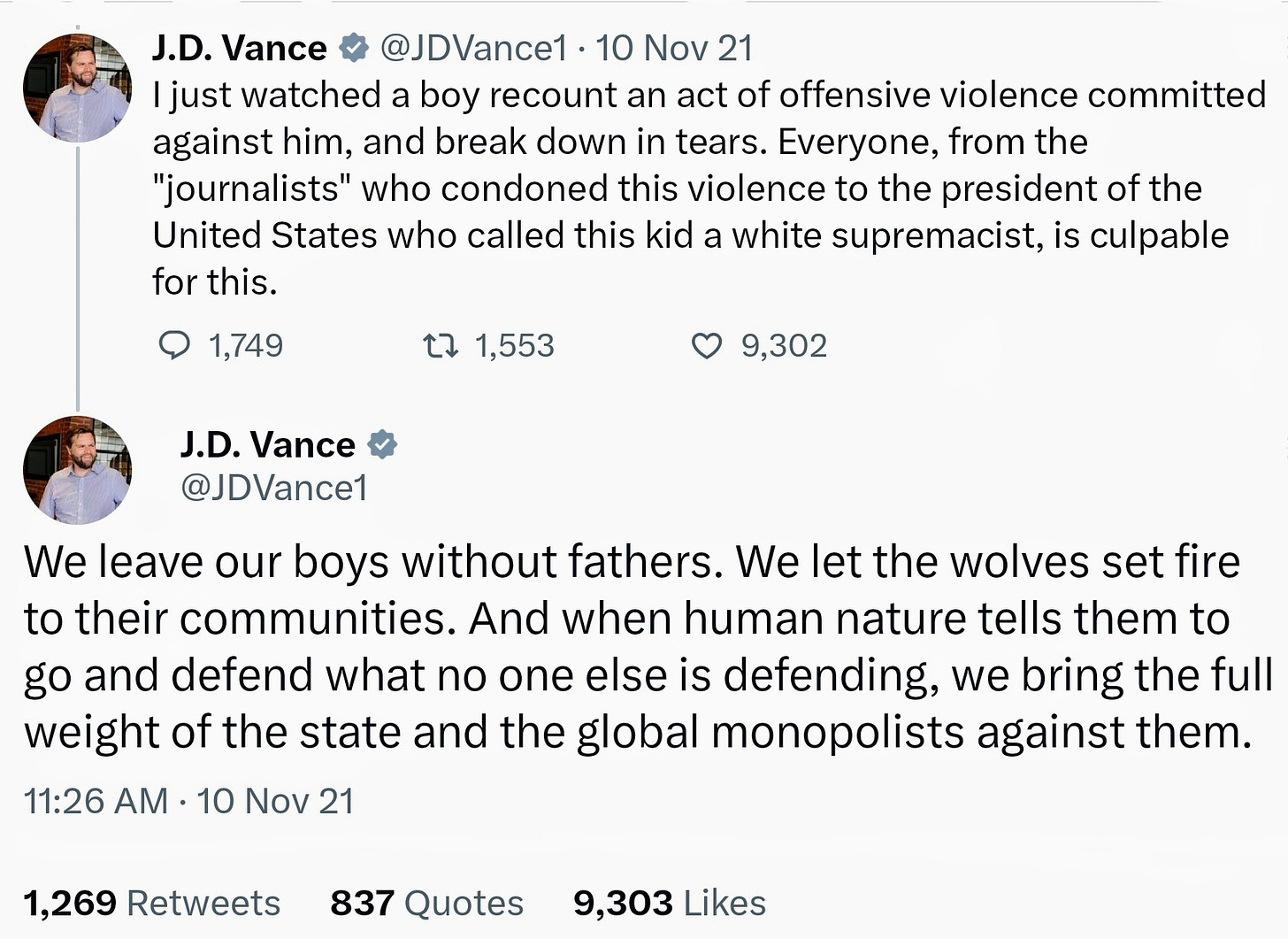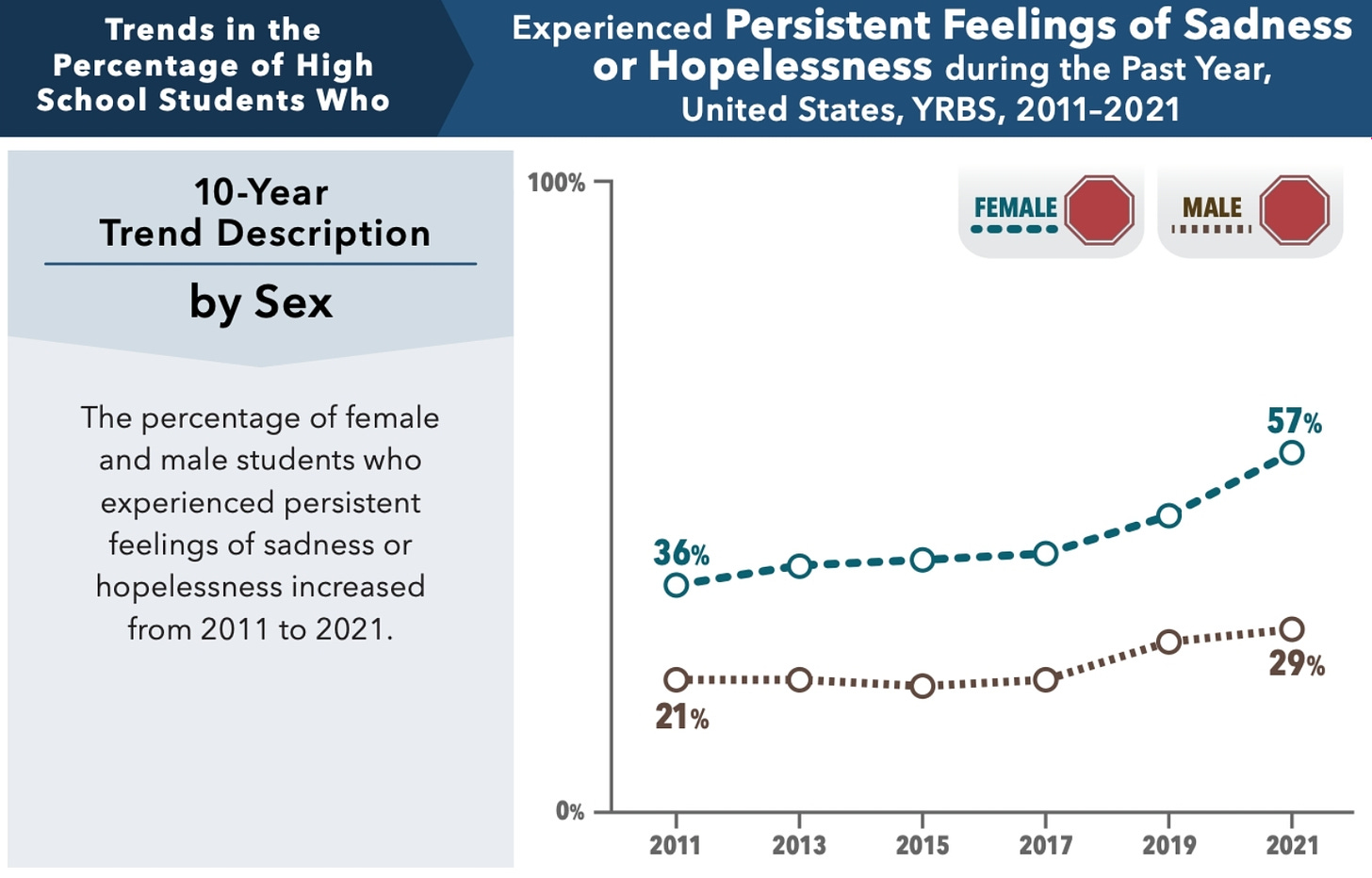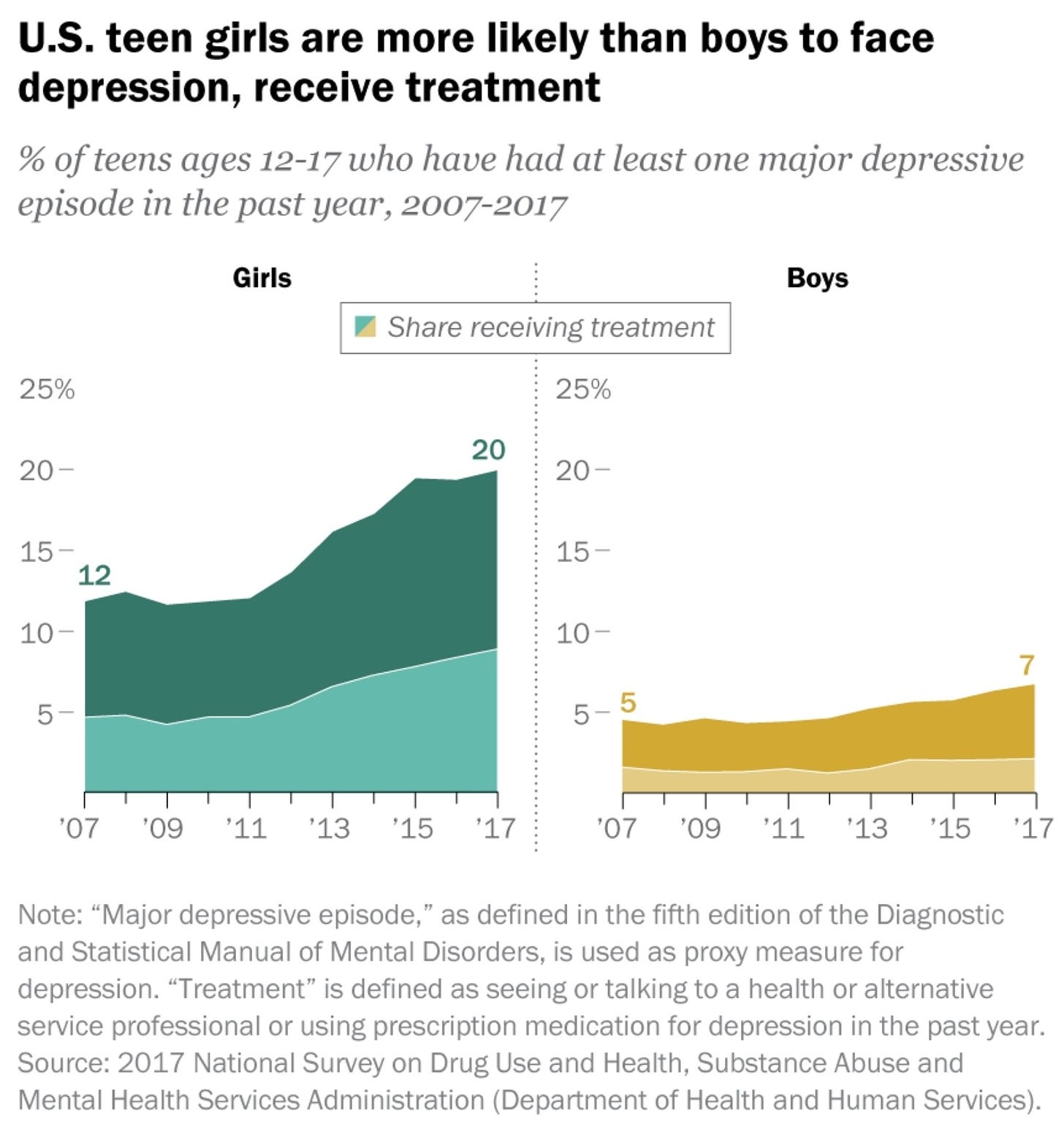Why Are We So Focused On Boys When Girls Are The Ones In Crisis?
What happened to create such a spike in depression after years of education and awareness about self-esteem and feminism?
Depression and anxiety are serious concerns for people of all ages. But it can be especially troubling in our youth.
For the last several years a great deal of attention has been paid to depression and anxiety in adolescent boys. The narrative states males are underserved in diagnosis and treatment because of social pressures to never ask for help or admit weakness.
But what about the girls? Are they getting the help they need such that rates of depression are dropping?
A recent study revealed just the opposite is true. Depression and anxiety has skyrocketed among teen girls.
This troubling reality needs to be addressed. This is what we'll discuss today in The Big Picture.
— George Takei
In 2021, The Wall St. Journal made waves with an article detailing the marked decline in male college enrollment.
This was followed up in 2022 by the release of the book Of Boys and Men: Why the Modern Male Is Struggling, Why It Matters, and What to Do About It by Richard V. Reeves of the Brookings Institution, who made the case that men are falling behind in the labor market and in health outcomes relative to women.
Over the past couple of years, the headlines trumpeting the apocalyptic decline of men and boys have been impossible to miss.
In fact, if you Google “men and boys falling behind” you get 1.3 billion results. Yes, with a b.
The narrative was particularly popular on the right, where the notion that men are the real victims of the left’s “woke” culture was like catnip, reinforcing their preconceived notions of the dangers of feminism.
As The Federalist alarmingly put it:
"The language of the left is dripping with radical feminist ideology…"
"Our entertainment, fashion, and media industries are all investing their capital in dismantling the alleged threat of 'the patriarchy'.”
"Pundits, health professionals, and even commercials denounce 'toxic masculinity'.”
Right-wing Missouri Republican Senator Josh Hawley, for one, appears to be making an entire career out of blaming the left for men’s ills. His new book is even called Manhood.
In a Washington Post article titled "Sen. Josh Hawley says liberals’ attacks on manhood are driving men to pornography and video games," Hawley is quoted as saying:
“Can we be surprised that after years of being told they are the problem, that their manhood is the problem, more and more men are withdrawing into the enclave of idleness and pornography and video games?”
“The Left want to define traditional masculinity as toxic. They want to define the traditional masculine virtues—things like courage and independence and assertiveness—as a danger to society.”
Similar sentiments were parroted by other Trump acolytes, such as one-term North Carolina Republican Representative Madison Cawthorn, who accused the left of trying to “demasculate” [sic] men:
“...because they don’t want people who are going to stand up.”
And there’s freshman Ohio Republican Senator JD Vance, who viewed the left’s outrage at Kyle Rittenhouse’s murderous vigilantism through a similar prism, tweeting:
"I just watched a boy recount an act of offensive violence committed against him, and break down in tears. Everyone, from the 'journalists' who condoned this violence to the President of the United States who called this kid a White supremacist, is culpable for this."
"We leave our boys without fathers. We let the wolves set fire to their communities."
"And when human nature tells them to go and defend what no one else is defending, we bring the full weight of the state and the global monopolists against them."
If right-wing mouthpieces are to be believed, you’d think women and girls are more than all right—that in fact, they must be dominating in all aspects of life. But this ignores the structural institutional impediments long placed in the way of women’s advancement.
And we now know it also ignores the very real mental health struggles teenage girls are experiencing relative to boys.
In February, the Centers for Disease Control released disturbing new data that documented a severe spike in mental health issues among teenage girls.
But you may have missed those headlines.
After all, a Google search for “Teenage girls mental health crisis” returned just 32.6 million results—1.2 billion fewer than ones focused on men and boys.
Teenage Girls’ Mental Health Struggles
The CDC’s recent Youth Risk Behavior Survey found that in the decade between 2011 and 2021, sadness and hopelessness among teenagers increased 40 percent. But for teenage girls, the picture looks particularly bleak.
As the topline of the CDC’s report explains:
"Across almost all measures of substance use, experiences of violence, mental health, and suicidal thoughts and behaviors, female students are faring more poorly than male students."
"These differences, and the rates at which female students are reporting such negative experiences, are stark."
On the question of whether they “experienced persistent feelings of sadness or hopelessness” in 2021, 57 percent of teenage girls felt this way, while only 29 percent of teenage boys did.
Ten years prior in 2011, a gender gap existed on this question as well but not quite as severe. In 2011, 36 percent of girls said they felt "...persistent feelings of sadness or hopelessness” and just 20 percent of boys did.
In other words, the gender gap on this measure almost doubled, going from 16 percent in 2011 to 28 percent in 2021.
On the question of whether they “experienced poor mental health,” 41 percent of girls in 2021 said yes, while just 29 percent of boys said the same.
Among those who reported “seriously considering suicide,” boys held steady from 2011 to 2021, going from 13 percent to 14 percent, while girls surged from 19 percent to 30 percent—a 21 percent increase.
As the CDC put it:
“America’s teen girls are engulfed in a growing wave of sadness, violence and trauma.”
The Washington Post calls it a “crisis in American girlhood” echoing the headlines we’d seen so many times before about boys.
Social Media’s Impact On The Mental Health Of Teen Girls
So what is the cause of such a dramatic uptick in mental health struggles?
We didn’t see such an uptick in 2001, with the attack on the World Trade Center. Nor in 2003/4 with the launch of the war in Iraq and the re-election of George W. Bush.
And not in 2008/2009, which saw the collapse of the housing market and the beginning of the Great Recession.
No, this phenomenon of declining mental health among teen girls seems to have begun around 2011/2012.
This data echoes a 2019 Pew Research Center (PRC) report, which found a similar gender gap.
PRC found:
"One-in-five teenage girls [20 %]—or nearly 2.4 million—had experienced at least one major depressive episode (the proxy measure of depression used in this analysis) over the past year in 2017.
"By comparison, 7 % of teenage boys (or 845,000) had at least one major depressive episode in the past 12 months."
"The total number of teenagers who recently experienced depression increased 59% between 2007 and 2017. The rate of growth was faster for teen girls (66%) than for boys (44%)."
Not only did the report find teenage girls much worse off than boys when it came to their mental health, but it also saw an acceleration around 2011/2012.
As Michelle Goldberg noted in The New York Times, this coincided with a turning point in our culture.
"Technology, not politics, was what changed in all these countries around 2012. That was the year that Facebook bought Instagram and the word 'selfie' entered the popular lexicon."
Goldberg cited data that found:
“In 2009, fewer than 60 percent of eighth-grade girls reported near-daily use of what were then called 'social networking sites'. By 2014, more than 80 percent did."
Indeed, 2012 saw not just Facebook’s acquisition of Instagram but it also announced its user base had exceeded 1 billion users. Nielsen found between 2011 and 2012, the number of minutes people spent on social media spiked 37 percent from 88 billion minutes to 121 billion minutes.
And the proliferation of mobile devices meant there was a 63 percent increase in use of social media sites and apps on mobile between 2011 and 2012. Notably, the iPhone 4—the first model with a front-facing camera—was released in 2010 which gave rise to selfie culture.
Social psychologist and author Jonathan Haidt, whose Substack After Babel is largely focused on the impact of social media on Gen Z’s mental health, called social media:
“...the largest single cause of the teen mental health epidemic that began around 2012.”
As Haidt explained:
“Gen Z’s in-person social lives were decimated by technology in the early 2010s.”
He added:
"2 hours a day with friends was the norm right up to the time when teens traded in their flip phones for smartphones, in the early 2010s. Once they did that, they moved their social lives onto a few large social media platforms, especially Instagram, Snapchat, and later Tiktok."
"They were spending vastly more time online, even when they were in the same room as their friends, which meant that they had far less time for each other (in face-to-face interaction or physical play).
Jean Twenge—a psychologist specializing in GenZ—echoed this conclusion. Twenge also posited why there may be such a dramatic gender gap.
As The Washington Post noted:
"[Twenge] said part of the problem is that digital media has displaced the face-to-face time teens once had with friends, and that teens often don’t get enough sleep."
"Adding to those influences are the hours teens spend scrolling social media. For girls, she said, this often means 'comparing your body and your life to others and feeling that you come up wanting'.”
"That’s not to say everything that people do on smartphones is problematic. It’s just social media in general and internet use show the strongest correlations with depression."
Haidt and Twenge have kept a record of all studies measuring the impact of social media on mental health.
"55 studies in their review found a significant correlation between time spent on social media and mood disorders, compared with 11 that found little or no correlation. Other research suggests a causal relationship.
Further bolstering the argument—and providing yet another perspective on why girls would be more impacted than boys—is a 2022 study that found the highest depression rates are among the most liberal teens, with girls being more liberal than boys.
And while the study concluded external political events were the most likely culprit, Goldberg disagreed.
"…as I looked closer at the data, I saw that the inflection point for liberal adolescent depression wasn’t 2016 [Trump’s election], but around 2012. That was the year of the devastating Sandy Hook mass shooting, but it was not otherwise a time of liberal political despair."
"Barack Obama was re-elected in 2012. In 2013, the Supreme Court extended gay marriage rights. It was hard to draw a direct link between that period’s political events and teenage depression, which in 2012 started an increase that has continued, unabated, until today."
For Twenge, the notion liberal girls would be the most depressed of all teens made all the sense in the world.
Per Goldberg:
"When I spoke to her last year, Twenge had preliminary data showing that liberal teenagers spent more time on social media than their conservative peers. Girls also use social media more than boys do, though boys tend to spend more time on screens, largely because of video games."
"Twenge pointed out that 'The Politics of Depression' found increases not just in depression but also in loneliness among liberal teenage girls. 'Why would they feel lonely because of the state of politics?' she asked."
The Politics Of Blaming Social Media For Teen Depression
Goldberg is sympathetic to those on the left who want to blame the decline in mental health among teenage girls on politics.
As Taylor Lorenz tweeted in February:
"People are like 'why are kids so depressed it must be their PHONES!' But never mention the fact that we’re living in a late stage capitalist hellscape during an ongoing deadly pandemic w/record wealth inequality, 0 social safety net/job security, as climate change cooks the world."
But as Goldberg explained, her prior assumptions along those lines were simply not backed up by the data.
And in fact, Goldberg concluded:
"The idea that unaccountable corporate behemoths are harming kids with their products shouldn’t be a hard one for liberals to accept, even if figures like Hawley believe it as well."
Of course, for right-wingers, the finding that teenage girls are worse off than teenage boys is an inconvenient narrative. After all, it was supposed to be the boys that were in decline.
The right was largely silent over the release of the CDC data.
To be fair, Hawley didn’t ignore it altogether. He simply spun the data into his preferred narrative of choice: the evils of social media.
In the wake of the CDC’s Youth Risk Behavior Survey, Hawley published an OpEd in The Washington Post titled:
Congress must act to keep kids off social media
In it, he calls for a minimum age verification of 16 for social media use, and he cited Twenge’s research in his one passing reference to the mental health crisis among teen girls.
Hawley buried the lede when he wrote:
"Social media has not connected or united the world. It’s tearing people apart. And young people are suffering the most."
"Researcher Jean Twenge, who has spent her career chronicling social media’s effects on kids, has observed that the longer children use social media, the more likely they are to harm themselves. This finding held true for both boys and girls—but especially girls."
For years, conservatives have railed against social media sites claiming they are liberal indoctrination breeding grounds that suppress conservative views.
After that line of attack was greatly undermined by Elon Musk’s takeover of Twitter, the recent research on the connection between social media use and depression gives the right a new angle of attack—one that actually appears to have a basis in reality.
But now it’s not just the Hawleys of the world working to limit teens’ social media use.
Even Biden’s Surgeon General Vivek Murthy spoke out, calling 13 too early for kids to get on social media and saying:
“None of this is out of our control. When we had dangerous vehicles on the road, we passed laws to make those vehicles less dangerous."
"We should make decisions to make [social media] a healthier experience that would make kids feel better about themselves and less alone.”
And Republican Governor Spencer Cox, widely seen as a reasonable (even “woke”) Republican, just signed two bills passed by the Utah state legislature to “limit how children can use social media.”
According to NPR, the bills “require parental consent before kids can sign up for sites like TikTok and Instagram” and
"…prohibit kids under 18 from using social media between the hours of 10:30 p.m. and 6:30 a.m., require age verification for anyone who wants to use social media in the state and seek to prevent tech companies from luring kids to their apps using addictive features."
But while these conservative measures seek to “ban” and “prohibit” teens from social media use, they ignore two important factors in the debate.
Finding Solutions
For all the consensus that exists around the harmful effects of social media on young people’s mental health, there are widely accepted benefits as well.
As Chief Science Officer for the American Psychological Association, Mitch Prinstein, PhD told the U.S. Senate in recent testimony:
“Perhaps most notably, psychological research suggests that young people form and maintain friendships online."
"These relationships often afford opportunities to interact with a more diverse peer group than offline, and the relationships are close and meaningful and provide important support to youth in times of stress.”
This is echoed by the results of a 2022 Pew Research Center Study of kids aged 13-17 who cite wide-ranging benefits of social media use.
“Eight-in-ten teens say that what they see on social media makes them feel more connected to what’s going on in their friends’ lives, while 71% say it makes them feel like they have a place where they can show their creative side."
"And 67% say these platforms make them feel as if they have people who can support them through tough times.”
Once again, we see in the data girls that are far more impacted by the negative effects of social media than boys, but it is a reminder that simply trying to limit teens’ social media use may be too blunt a tool.
As Adam Kovacevich, CEO and Founder of the Chamber of Progress, says:
“There is a right way to create a healthier world for kids online. Just as we would help young people navigate situations in the physical world, it’s our job to help kids navigate the internet safely and responsibly in the same way."
"Creating a safer internet for children requires intentional work to educate, supervise and safeguard their online experience without depriving them of the critical benefits that internet access can bring.”
To this end, the APA’s Prinstein made several recommendations for action by Congress to help mitigate the negative effects while maintaining the benefits:
Allocating at least $100 million to study social media and adolescent mental health;
Mandating that data from algorithms be made public, along with other internal research conducted by social media companies;
Requiring social media platforms to develop tools to mitigate the harm to youth, such as disabling particularly addictive features and enabling users to opt out of certain algorithms;
Mandating protections for marginalized and LGBTQ+ kids, while retaining their ability to connect with others in such groups for social support;
But where in all of these bills and recommendations is an increase in mental health services, particularly in our high schools? And particularly for our girls?
While teen girls may be graduating high school and enrolling in college at higher rates than boys, the data is overwhelming that there needs to also be a focus on mitigating the depressive effects of social media use on them.
One bill introduced in Maine by Democratic lawmaker Lydia Crafts––also an outpatient counselor––may serve as a model for bringing more mental health support to teens where they actually are: in school.
The bill would:
Help train school staff in behavior support
Reduce the ratio of school counselors to students in elementary and middle schools
Create a new ratio for clinical social workers to students at all school levels
Require school social workers to spend at least 80 percent of their time providing direct services to students
Said Crafts of her bill:
“My hope is that it's really going to reduce some of the barriers that families are facing in trying to connect their kids with the type of support they need.”
As one school-based clinician, Phoebe Smith, put it:
“Being in the school, that eliminates a barrier right there. I’m where the children are.”
It’s certainly a place to start.









As a teacher, I will say that many girls with depression remain unseen - they are quiet, withdrawn, and generally compliant, in contrast to boys, who are much more likely to be disruptive. Based on that, boys are more likely to get attention, in the school system, in the community, and at home. This is similar to why girls are underdiagnosed with autism and ADHD, and why women are underdiagnosed with things like cardiac problems - because the baselines were are developed with male patients, and the assumption is that the symptoms seen in males are similar to those seen in females - and they are wrong. This is a basic problem with medicine, which as been recognized in medicine, but is only slowly being dealt with.
Has anyone asked Hawley why "things like courage and independence and assertiveness" are "masculine?" Feminists are not attacking those things as toxic. They are claiming the right to HAVE those virtues instead of being described as emotional, hysterical, stubborn, or generally uppity when they manifest those virtues.
And now there is a new prong to the argument that women can't have those virtues. Because they are "masculine" it will become commonplace to insist that any woman who evidences them must be "trans."
There may not have been any one political event in 2012 that would discourage girls. Women have made great strides in their ability to enter the "male" world but they STILL encounter that perception that so much of what they do WITHIN that male world is uppity. Ask any woman who has sat on a committee and had her contribution ignored until some male advanced it often in her exact words and received applause for the great idea. Ruth Bader Ginsburg has pointed out that she experienced EXACTLY the same thing.
Maybe girls are simply becoming aware through whatever means--social media or TV or simply being in some classrooms--that this phenomenon isn't going away. Solnit described Mansplaining in 2008, but it takes a while for a teen to learn about it and then experience it.